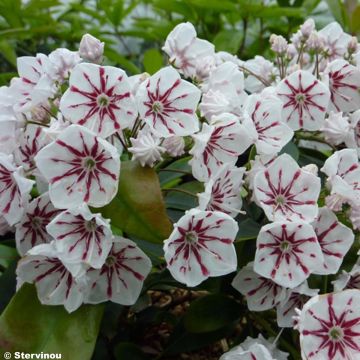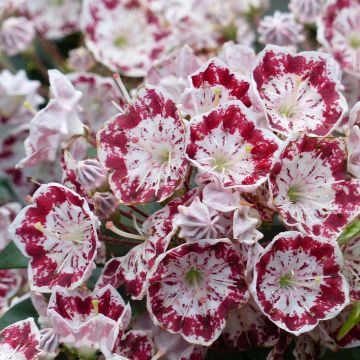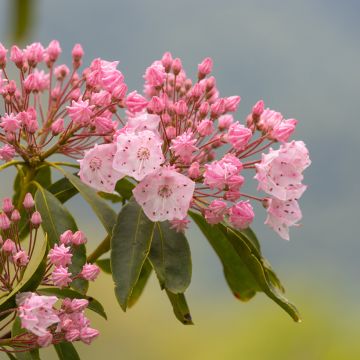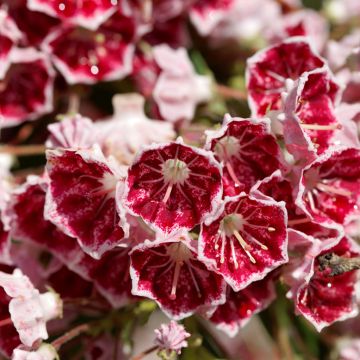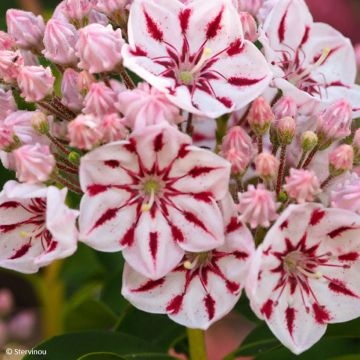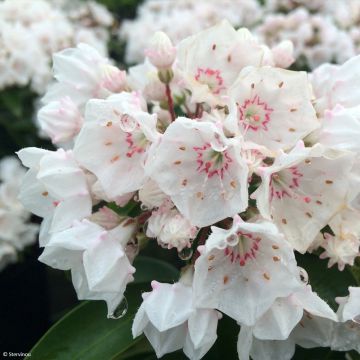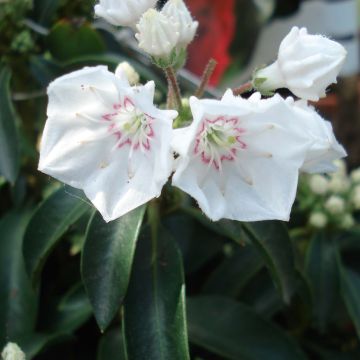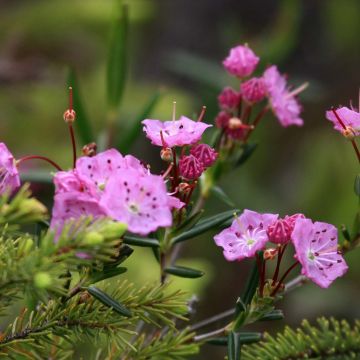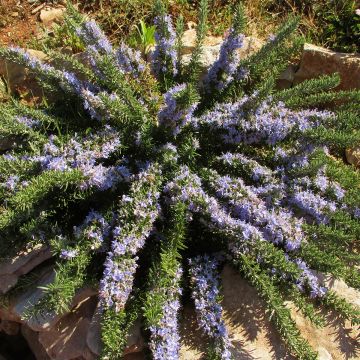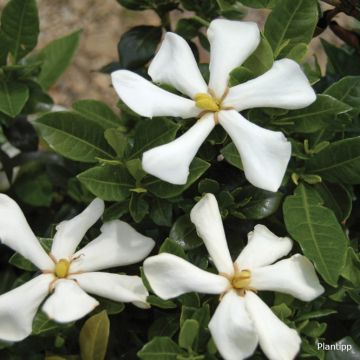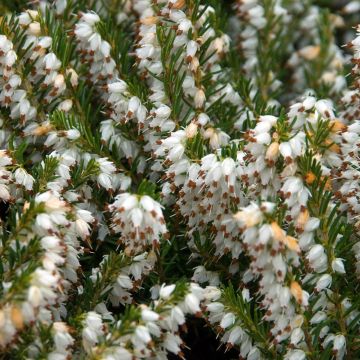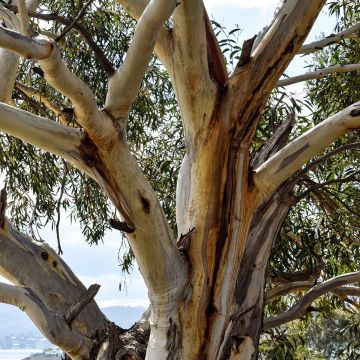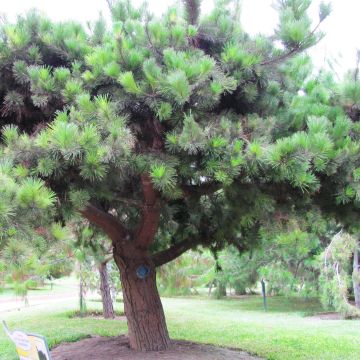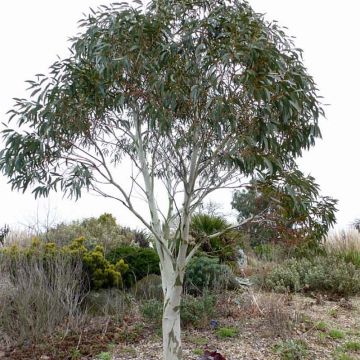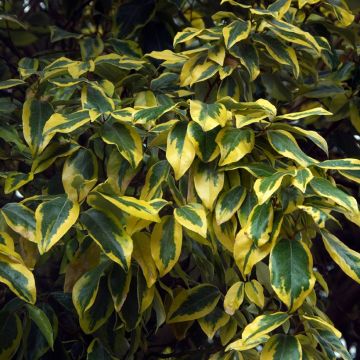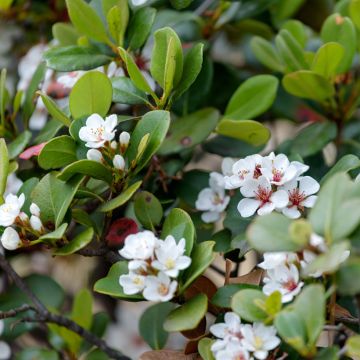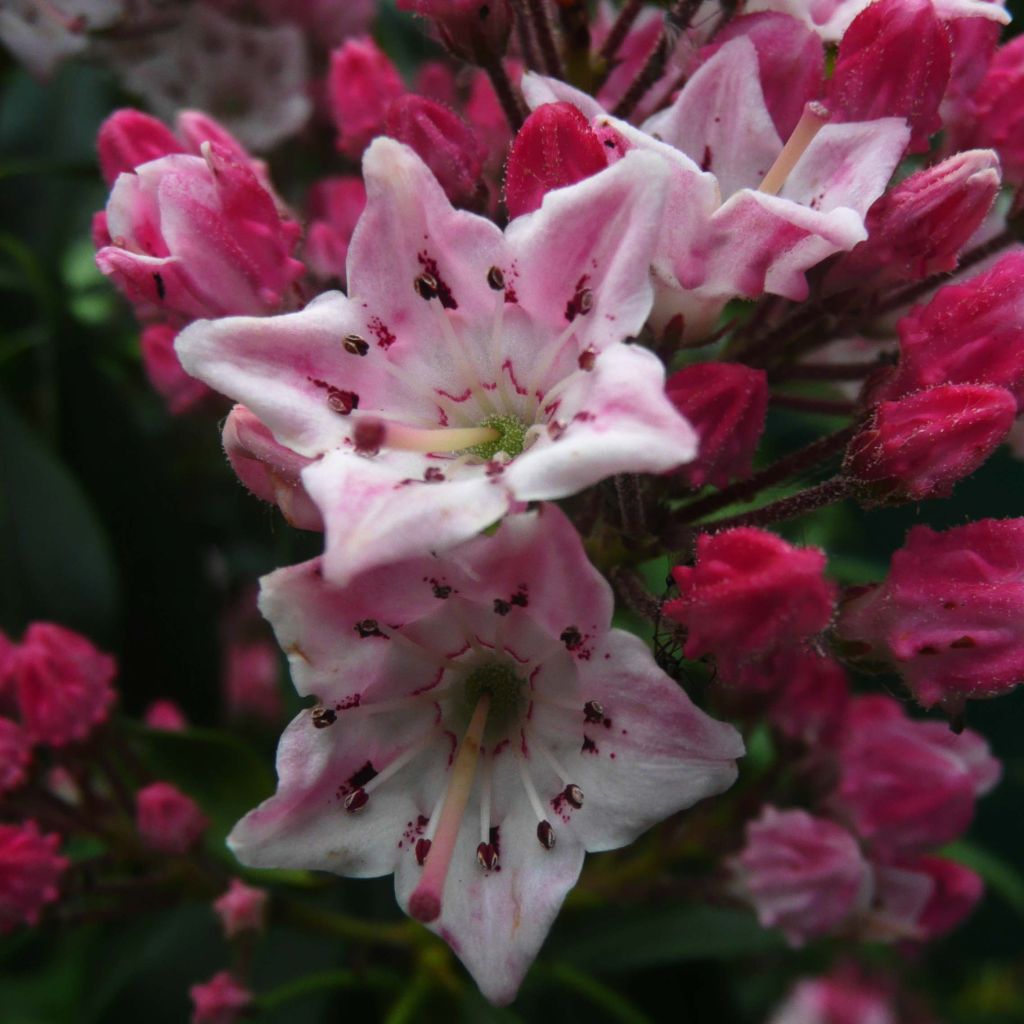

Kalmia latifolia Otsbo Red - Laurier des montagnes rouge et rose vif.
Kalmia latifolia Otsbo Red - Mountain Laurel
Kalmia latifolia Otsbo Red
Mountain Laurel, Calico Bush, Spoonwood, American Mountain Laurel, Broad-leaved Kalmia
Special offer!
Receive a €20 voucher for any order over €90 (excluding delivery costs, credit notes, and plastic-free options)!
1- Add your favorite plants to your cart.
2- Once you have reached €90, confirm your order (you can even choose the delivery date!).
3- As soon as your order is shipped, you will receive an email containing your voucher code, valid for 3 months (90 days).
Your voucher is unique and can only be used once, for any order with a minimum value of €20, excluding delivery costs.
Can be combined with other current offers, non-divisible and non-refundable.
Why not try an alternative variety in stock?
View all →This plant carries a 24 months recovery warranty
More information
We guarantee the quality of our plants for a full growing cycle, and will replace at our expense any plant that fails to recover under normal climatic and planting conditions.
Would this plant suit my garden?
Set up your Plantfit profile →
Description
Kalmia latifolia 'Otsbo Red' is a historical variety of mountain laurel, the one that first showed red flower buds. If its habit lacks a bit of density, its flowering is simply delightful: bright red in bud, they bloom into bright pink corollas, fading into a softer pink flowers. The whole plant creates an amazing display in a range of pink and red, all the more brilliant if the shrub benefits from a sunny position. It flowers abundantly, even when young, and remains elegant all year round, with its beautiful matte green foliage.
Kalmia latifolia, native to the mountains of eastern North America, and also known as Mountain Laurel or American Laurel, belongs to the Ericaceae family, like Heather and the Rhododendron. This broad-leaved Kalmia Otsbo Red, selected in 1940 in the U.S.A, is a modestly sized, evergreen bush, not exceeding 1.50m (4 ft 11 in) in height for 2m (6 ft 7 in) in width, and of slow growth. The adult size is reached in ten years, the plant can live 50 years. Its branched trunk gives it a bushy habit, spread out and somewhat ungainly. Its matte green evergreen foliage, with a lighter underside, is made up of small concave, leathery and thick, alternate and lanceolate leaves (like those of Rhododendrons or Laurels), thus guaranteeing a very decorative interest all year round. In Otsbo Red, the leaves are a bit narrower and more twisted than in most varieties. The plant is at its peak in May-June, when its flowers appear. Each branch carries terminal clusters (corymbs) of small pink flowers which are redder on the outside and pink to rose white on the inside. These are 5-sided, very flared, campanulate corollas, 2 to 2.5 cm (0.8 to 1 in) in diameter, each petal bordered in white. Each flower carries 10 stamens with dark red anthers housed on the petals. The flowers do not bloom all at once, the corymbs present astonishing contrasts between the bright cherry red unopened floral buds, and the already bloomed pink flowers. After flowering, if they have not fallen, the flowers give way to fruits in the form of brown capsules, which last through winter.
Kalmias are unjustly overlooked. Their flowering is enchanting, they are particularly hardy heathland bushes that should be planted in semi-shade, in moist and humus-rich soil. Highly decorative and too little known, Kalmia Otsbo Red will look wonderful planted in the garden, where it will beautifully highlight all the plants around it! It can be used in many ways. It will be the ideal companion for ericaceous plants (Rhododendrons, Azaleas, Camellias, Heathers, Hydrangeas, Japanese Maples, Magnolias, Andromedas, Cyclamens...). This kalmia pairs particularly well with Rhododendron canescens, Euonymus americana (the American purple spindle in autumn), Dicentra eximia, Polystichum acrostichoides (a pretty fern), Gillenia trifoliata (excessively light) and Leucothoe axillaris with its crimped and changing foliage.
Properties :
Kalmia latifolia is a shrub which is entirely toxic to humans as well as for animals (dogs, cats, sheep, horses) when eaten, including its leaves, flowers, fruits and roots.
However, it is used in homeopathy for pain relief. In the past, its very hard wood was used to make many tools, including wooden spoons, hence its English nickname of Spoonwood.
Anecdote :
The genus name Kalmia, was chosen by Carl von Linne, in tribute to Pehr Kalm, famous Swedish botanist, who was one of the first to explore the flora in certain parts of North America from 1747 to 1751.
The flower of the Kalmia latifolia is the emblem of the states of Connecticut and Pennsylvania.
Report an error about the product description
Kalmia latifolia Otsbo Red - Mountain Laurel in pictures
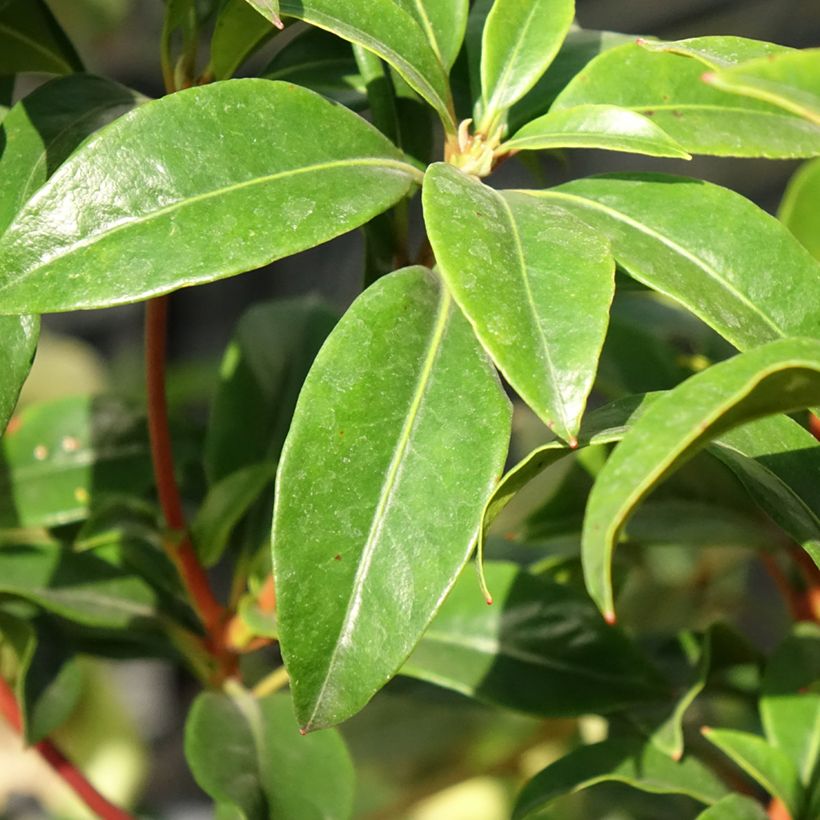

Plant habit
Flowering
Foliage
Botanical data
Kalmia
latifolia
Otsbo Red
Ericaceae
Mountain Laurel, Calico Bush, Spoonwood, American Mountain Laurel, Broad-leaved Kalmia
North America
Other Kalmias
View all →Planting and care
Native to the mountains of eastern North America, Kalmia latifolia is extremely hardy and can withstand very low temperatures, below -20°C (-4 °F). Belonging to the Ericaceae family, it needs to be planted in a semi-shaded position, in a humus-rich and fertile soil, acidic, moist but well-drained. Plant in spring or autumn, avoiding periods of frost or high heat. Prepare a wide and deep pit, 40 cm (15.7 in) by 40 cm (15.7 in) so that your Kalmia can quickly establish itself. Regular watering in the first few weeks after planting is necessary to keep the soil moist. A mulch at the base of the plant can be beneficial to protect the thin and superficial roots. Each spring, scratch the soil around the base of the plant and top with compost, ericaceous soil and mulch. If the soil is calcareous, it will need to be completely replaced by a mix of ericaceous soil and leaf compost in a large planting pit. The mountain laurel dislikes scorching situations and sweltering summers. It must be placed in such a way that it is shaded during the hottest hours of the day. The mountain laurel dislikes exposure to strong sunlight, especially in case of drought, and ensure regular watering (preferably with rainwater). This summer watering is particularly important since this is when the flower buds form for the following spring. The mountain laurel, liking coolness and good humidity, will thrive in coastal or rainy climates. With its slow growth, it is well suited to pots on a patio or balcony but use a large pot and water well to avoid the soil from drying out. Apart from removing faded flowers, pruning of Kalmia latifolia is hardly necessary. Indeed, it risks damaging the flowers for the following year, as the flower buds form at the ends of the branches. However, it is possible to remove dead wood and carry out a very slight refreshment to maintain a balanced habit.
Planting period
Intended location
Care
This item has not been reviewed yet - be the first to leave a review about it.
Similar products
Haven't found what you were looking for?
Hardiness is the lowest winter temperature a plant can endure without suffering serious damage or even dying. However, hardiness is affected by location (a sheltered area, such as a patio), protection (winter cover) and soil type (hardiness is improved by well-drained soil).

Photo Sharing Terms & Conditions
In order to encourage gardeners to interact and share their experiences, Promesse de fleurs offers various media enabling content to be uploaded onto its Site - in particular via the ‘Photo sharing’ module.
The User agrees to refrain from:
- Posting any content that is illegal, prejudicial, insulting, racist, inciteful to hatred, revisionist, contrary to public decency, that infringes on privacy or on the privacy rights of third parties, in particular the publicity rights of persons and goods, intellectual property rights, or the right to privacy.
- Submitting content on behalf of a third party;
- Impersonate the identity of a third party and/or publish any personal information about a third party;
In general, the User undertakes to refrain from any unethical behaviour.
All Content (in particular text, comments, files, images, photos, videos, creative works, etc.), which may be subject to property or intellectual property rights, image or other private rights, shall remain the property of the User, subject to the limited rights granted by the terms of the licence granted by Promesse de fleurs as stated below. Users are at liberty to publish or not to publish such Content on the Site, notably via the ‘Photo Sharing’ facility, and accept that this Content shall be made public and freely accessible, notably on the Internet.
Users further acknowledge, undertake to have ,and guarantee that they hold all necessary rights and permissions to publish such material on the Site, in particular with regard to the legislation in force pertaining to any privacy, property, intellectual property, image, or contractual rights, or rights of any other nature. By publishing such Content on the Site, Users acknowledge accepting full liability as publishers of the Content within the meaning of the law, and grant Promesse de fleurs, free of charge, an inclusive, worldwide licence for the said Content for the entire duration of its publication, including all reproduction, representation, up/downloading, displaying, performing, transmission, and storage rights.
Users also grant permission for their name to be linked to the Content and accept that this link may not always be made available.
By engaging in posting material, Users consent to their Content becoming automatically accessible on the Internet, in particular on other sites and/or blogs and/or web pages of the Promesse de fleurs site, including in particular social pages and the Promesse de fleurs catalogue.
Users may secure the removal of entrusted content free of charge by issuing a simple request via our contact form.
The flowering period indicated on our website applies to countries and regions located in USDA zone 8 (France, the United Kingdom, Ireland, the Netherlands, etc.)
It will vary according to where you live:
- In zones 9 to 10 (Italy, Spain, Greece, etc.), flowering will occur about 2 to 4 weeks earlier.
- In zones 6 to 7 (Germany, Poland, Slovenia, and lower mountainous regions), flowering will be delayed by 2 to 3 weeks.
- In zone 5 (Central Europe, Scandinavia), blooming will be delayed by 3 to 5 weeks.
In temperate climates, pruning of spring-flowering shrubs (forsythia, spireas, etc.) should be done just after flowering.
Pruning of summer-flowering shrubs (Indian Lilac, Perovskia, etc.) can be done in winter or spring.
In cold regions as well as with frost-sensitive plants, avoid pruning too early when severe frosts may still occur.
The planting period indicated on our website applies to countries and regions located in USDA zone 8 (France, United Kingdom, Ireland, Netherlands).
It will vary according to where you live:
- In Mediterranean zones (Marseille, Madrid, Milan, etc.), autumn and winter are the best planting periods.
- In continental zones (Strasbourg, Munich, Vienna, etc.), delay planting by 2 to 3 weeks in spring and bring it forward by 2 to 4 weeks in autumn.
- In mountainous regions (the Alps, Pyrenees, Carpathians, etc.), it is best to plant in late spring (May-June) or late summer (August-September).
The harvesting period indicated on our website applies to countries and regions in USDA zone 8 (France, England, Ireland, the Netherlands).
In colder areas (Scandinavia, Poland, Austria...) fruit and vegetable harvests are likely to be delayed by 3-4 weeks.
In warmer areas (Italy, Spain, Greece, etc.), harvesting will probably take place earlier, depending on weather conditions.
The sowing periods indicated on our website apply to countries and regions within USDA Zone 8 (France, UK, Ireland, Netherlands).
In colder areas (Scandinavia, Poland, Austria...), delay any outdoor sowing by 3-4 weeks, or sow under glass.
In warmer climes (Italy, Spain, Greece, etc.), bring outdoor sowing forward by a few weeks.






























